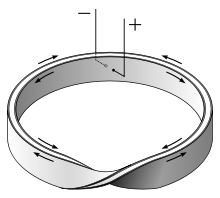Möbius resistor

Current in a Möbius resistor
A Möbius resistor is an electrical component made up of two conductive surfaces separated by a dielectric material, twisted 180° and connected to form a Möbius strip. As with the Möbius strip, once the Möbius resistor is connected up in this way it effectively has only one side and one continuous surface. Its connectors are attached at the same point on the circumference but on opposite surfaces. It provides a resistor that has no residual self-inductance, meaning that it can resist the flow of electricity without causing magnetic interference at the same time.
Patents
- U.S. Patent 4,599,586, Möbius capacitor
- U.S. Patent 3,267,406, Non-inductive electrical resistor
- U.S. Patent 6,611,412, Apparatus and method for minimizing electromagnetic emissions of technical emitters Dietrich Reichwein
See also
References
- "Making Resistors with Math", Time, 84 (13), September 25, 1964
- US patent 3,267,406, R. L. Davis, "Non-Inductive Electrical Resistor", issued 1966-08-16
- "Moebius Resistor is Noninductive & Nonreactive", AEC-NASA Tech. Brief (68–10267), 1968
- Hyypia, Jorma (November 1969), "At Ultra-High Frequencies Electronic Components Take On Weird Shapes!", Electronics Illustrated, 12 (5), pp. 76, 77, 117
External links
This article is issued from
Wikipedia.
The text is licensed under Creative Commons - Attribution - Sharealike.
Additional terms may apply for the media files.